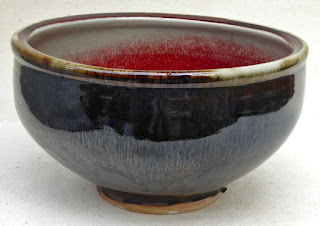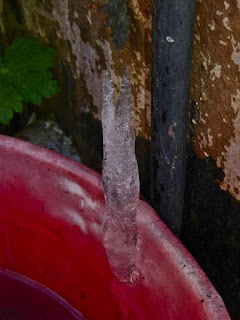 |
| Porcelain bowl H 135 x W 240mm (H 5.3 x W 9.5 inches). |
 |
| Copper red glaze inside, rutile glaze over tenmoku outside. |
 |
| Fascinating pattern in the glaze where it pools in the bottom of the bowl. |
This is a sample of some of the pots that were in the 22 March firing of my wood fired kiln. The firing was 10 hours long with nearly 2 and a half hours of that above 1200 Celsius (2192 F). The hottest part of the kiln was about 1300 Celsius (2372 F) with cone 11 down, and the coolest was cone 8 which is about 1250 C (2282 F. The clay used was mostly a mixture of porcelain and stoneware that I blended "by eye" to suit what I wanted. I favoured using a more iron rich mixture for the shino glazed work, and a whiter body for the copper reds.
 |
| Stoneware bowl. H 90 x W 255mm (H 3.5 x W 10 inches). |
 |
| Poured rutile glazes over tenmoku. |
 |
| Rutile forms tiny crystals in a glaze that make it mottled and interesting. |
 |
| Urn. H 270 x W 180mm (H 10.6 x W 7 inches). |
 |
| Rutile glaze over Tenmoku. |
 |
| Small crystals sparkle in the glaze. |
 |
| Pouring bowl. H 95 x W 145mm (H 3.7 x W 5.7 inches). |
 |
| Runny Ash Glaze over Shino Glaze. |
 |
| Pouring Bowl. H 85 x W 150mm (H 3.3 x W 5.9 inches). |
 |
| Flowing Ash Glaze over Saturated Iron Glaze. |
 |
| A spiral of iron red picks out the throwing ring in the center of the bowl. Where the iron glaze is thicker the glaze moves through red to purple and there are numerous scintillating iron crystals. |
 |
| Pouring Bowl. H 95 x W 150mm (H 3.7 x W 5.9 inches). |
 |
| Rutile glaze over Tenmoku. |
 |
| Mugs. Assorted sizes H 90 - 100 x 85mm diameter at rim (H 3.5 - 3.9 x D 3.3 inches) |
 |
| Shino glaze with splash of Celadon. |
 |
| Mugs. H 110 x 100 Diameter at rim (H 4.3 x D 3.9 inches) |
 |
| Flowing ash glaze over matte white glaze. |
 |
| Mugs with ring handles. H 105 x 85 diameter at rim (H 4.1 x D 3.3 inches) |
 |
| Flowing ash glaze over matte white glaze. |
 |
| Vase with flowing ash glaze over shino glaze. H 150 x W 160mm (H 5.9 x W 6.3 inches). |
 |
| Vase with rutile glaze over tenmoku. H 120 x W 150mm (H 4.7 x W 5.9 inches). |
 |
| Teapot with alkaline matte copper glaze outside and tenmoko inside. H 130 x L 220 x W 125mm (H 5.1 x L 8.7 x W 4.9 inches). Capacity 2.5 standard cups. |
 |
| Teapot, thrown and modified. Saturated iron glaze. H 120 x L 230 x W 130mm (H 4.7 x L 9 x W 5.1 inches). Capacity 2.5 standard cups. |
 |
| Note the squared form. |
At the time of writing I have all these pots in stock in our gallery, but have already sold other work from the firing, some will be on its way to Australia. I have other pouring bowls and mugs in stock that are similar to ones shown here and, if any of my readers are interested, I am happy to ship work overseas or around NZ. Please contact me for price and availability.
Notes....
Ash glaze. Wood ash can form its own glaze if fired above about 1200 degrees Celsius. Wood ash contains all the ingredients necessary to make a glaze, but is usually too high in fluxes to be practical on its own. Simple useful glazes can be made with just wood ash and clay, but possibilities abound if feldspar is also added.
Porcelain. Traditionally this is a high fired, translucent, vitrified clay body that is usually made from china clay (Kaolin), feldspar and silica. Sometimes a little bentonite or ball clay is added to improve the plasticity of the porcelain. Some "low fired porcelains" exist, but these are unlikely to have the hardness of their high fired relatives because they will contain a higher proportion of fluxes in relation to the silica and alumina in order to vitrify at a lower temperature.
Rutile (as in rutile glaze) is natural titanium dioxide with a trace of iron oxide and other impurities. Rutile tends to form crystals in glazes which can make a glaze opaque. In slightly smaller quantities rutile can make make lovely pale mottles and streaks which adds excitement to the glaze. Otherwise colourless glazes that contain rutile, can yield an optical blue when layered over a dark glaze, such as a tenmoku glaze. In this case the semi opaque rutile glaze acts as a filter for the light and blue light is reflected back to the viewer whilst other parts of the spectrum are absorbed by the dark glaze underneath.
Shino glaze. Often a fairly simple mix of feldspar and clay that would fire a rather uninspired white in an electric kiln, Shino glazes need to be fired in a fuel fired kiln in a reduction atmosphere followed by a period of oxidation to obtain their colour. The warm orange or rusty red of a shino glaze is derived from the iron oxide that is in the clay that the pot is made of.
Tenmoku, a dark brown or black glaze that contains usually contains about 8 to 10 percent iron oxide. Some tenmoku glazes will "break" attractively to a rusty red, orange or pale brown where they are thin, such as over rims of cups.





























Comments
Thank you for your encouragement, very nice to hear from you both.
Lovely to hear from you, but do take care of your keyboard! I was really thrilled with the copper red, it seems to be going well at the moment. The rutile over tenmoku is a really good thing to explore. The dark tenmoku nicely absorbs a lot of the light that travels through the rutile glaze, and you are left seeing the short wave blue end of the spectrum that can't easily pass through the rutile filter! Result, optical blues over a near black background! I've also had interesting results in the past with rutile glazes over copper red.
Thanks so much for the encouragement, it means a lot!
Peter